
The high mileage we do in our car necessitates a fare few tyre changes, and over those 90,000 miles we have tried a few different types of tyre. We have had experience of Michelin Pilots, Yokohama AO-32r's, 21r's and 48r's. I shall write my thoughts on each type here, both on road and track.
First thing to point out is that tyres are a very subjective thing. People like different things in their car and its handling, and the same with tyres. Some people like a car that is 'a bit loose', others prefer ultimate grip and stiff, taught handling. The opinions here are only my own, and relate to our car and our experiences. I don't expect everyone to agree with all my experiences, but this may help as a guide.
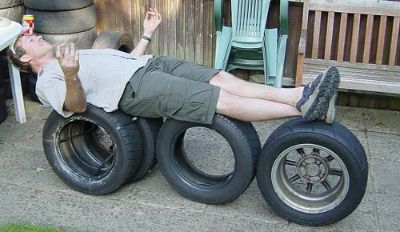 Peter C and the art of Tyre Zen. Peter C and the art of Tyre Zen.

These tyres were fitted when we bought the car. They looked in good condition with very little wear on the tread, and a good 5-6mm left across the full width of the car. This was our first Caterham so we had no comparison on any aspect of our car, and we relished the new levels of handling and grip we experienced. We toured Europe on a 6 week, 8000 mile trip and piled the miles on upon our return. Still the tyres looked remarkably unworn! Gradually we met more and more fellow Caterham owners and at some point we must have picked up on the fact that we could probably do better on the tyre front.
In fact the advice went something like “Don’t wait for them to wear out – they never will. Dump them now!!”
Umm – ok, that’s pretty clear, but what to replace them with? After asking the most common Blatchat question ‘What tyres should I blah blah blah……?’ I settled on a replacement for our Pilots. I ordered the new rubber, and when the fitter removed the Pilots from our car he told us that they were 5 years old – pretty much as old as the car, and well past their sell by date. Closer inspection revealed that they were starting to look and feel a little more like plastic than rubber. We would have waited another 10,000 miles to see them wear out, and it became apparent later that changing them was the best upgrade we could have done to our car!
Rough price guide: No idea - don't buy them!!

This was the tyre I chose to replace the aging Pilots with, on the advice of many other Caterham owners. The 32’s had been recommended as being a great tire for road and track, particularly effective in the dry. But I was also warned that they may not perform so well as more ‘conventional’ tyres in the wet, and particularly standing water, when they are more prone to aqua-planning.
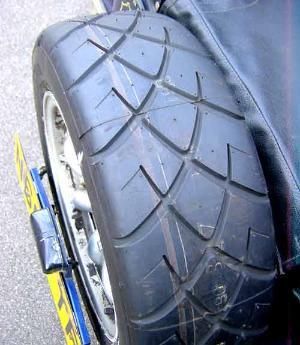 Yokohama A0-32r. These tyres are directional. Yokohama A0-32r. These tyres are directional.
Quite frankly it soon became apparent that whatever the conditions the tyres would be safer than the Pilots we had just taken off. As I started to drive with the 32’s it made me realize how bad the Pilots had been.
Perhaps the biggest difference in road use was the braking. With the Pilots one could brake pretty hard (compared to a ‘normal’ car) but soon one or more of the wheels would lock up – quite often the rears (though it is generally acknowledged that Caterhams can be over-braked at the rear).
With the new A0 32r’s fitted you could really stand on the brakes and feel the softer rubber grip as the car rapidly decelerated.
Another handling change was that the car felt much more ‘pointy’. Turn in was much sharper and direct. This was partly as a result of the additional grip of the tyre as you changed direction, and also because the new tyres had a ‘squarer’ profile than the old Pilots. This also meant that the car was more prone to tramlining – the followowing of road camber or surface changes – than before. This was not excessive though, but it does take a few days to get used to the different feel of the car. Don't be put off by initial feel and take time to get used to the change, which is only likely to be so obvious if you are changing from a totally different tyre design and structure.
We drove in all conditions all year with the AO32's, getting through 2 or 3 sets. We drove many miles in the wet, and the tyres were still superior to the old Pilots. We did have two 'brown trouser' aquaplaning moments (both on the A303 by chance) but I think people get over sensitive about the wet weather performance on the road, and we never had any real problems. Put the aqua-planing moments down to driver error/simply going too fast for conditions etc. I tend to slow right down in the wet anyway - its just not worth the risk in such a light car as the Caterham, but using these tyres on a wet track where we could push with less risk showed just how good they are in wet conditions.
Rough price guide (185/60/14): £45

 Yokohama A0-21r Yokohama A0-21r
We bought some A0-21r's on one occasion when we could not get hold of any 32's. Straight away I could feel the extra 'squirm' of these tyres compared to the 32's which is as a result of the tread blocks moving a bit more. As it happened, much of the following 6 months motoring was in torrential rain, including two track days at Spa and a few continental trips. I was impressed with how they felt and it is true to say I felt more 'secure' in the wet than I would have done with the 32's.
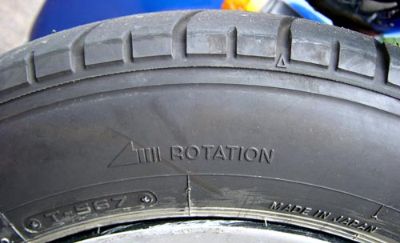 Directional arrow as seen on the A0-21r. The same can be found on the 32r's and the 48r's. Vitally important for safe wet weather driving. Directional arrow as seen on the A0-21r. The same can be found on the 32r's and the 48r's. Vitally important for safe wet weather driving.
I missed the extra grip of the 32's in the dry on track but was still impressed with the 21r over all. As many people suggest, it has to be one of the best options for an 'all round' tyre, and if you have any doubts about the wet weather handling of the 32's or 48's these are the ones to go for. The only real disadvantage you might find is that the tyres may overheat more quickly on a dry track day. An excellent tyre, especially for all year road driving.
Rough price guide (185/60/14): £35

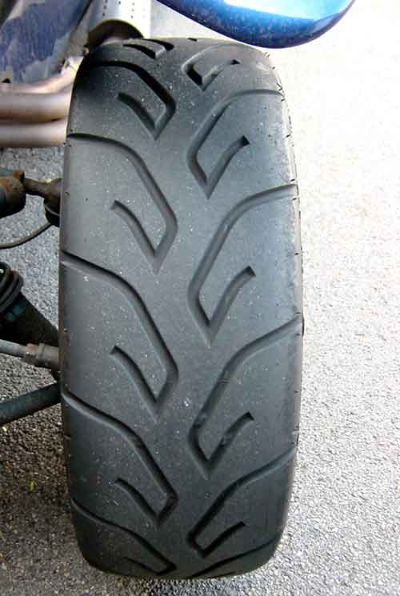 Yokohama AO-48r Yokohama AO-48r
The A0-48r is a relatively new tyre from Yokohama. It is similar in style to the 32r, but is a new design. Its biggest advantage over the 32r is its performance in wet conditions and particularly standing water.
Our first drive and the car felt very 'planted' right away. Partly because the tyres we had been driving on just before were so past their sell by date, but I was also aware that there was more rubber on the road - a 'seat of the pants' thing really. The tyres are very quiet on smooth roads (opposite affect of the buzzing noise you get when a knobbly tired Land Rover drives past - you get a similar humming effect with new 21'rs ) and they 'smack' quite loudly over cats eyes.
On the day we fitted them we drove 140 miles down to Somerset, and on the way went through a HUGE amount of really heavy rain. There was a large amount of standing water on the motorway - obviously we had slowed down, but car felt fine. In fact a few days later we were on the M1 at night, motorway damp but not raining. We suddenly came across one of those 'streams' across the road (these are what had caused my aqua-planing moments on the A303 with A0-32r's) and I braced myself for 'impact' - whilst keeping my hands relaxed on the wheel I might add. Not a thing - in fact I did not really notice that the water was there, with no pulling or sudden jolts. Of course, all this is a hugely subjective thing, but hopefully it gives an idea - and of course as a bonus the tyres look fantastic - like wide superbike treads!
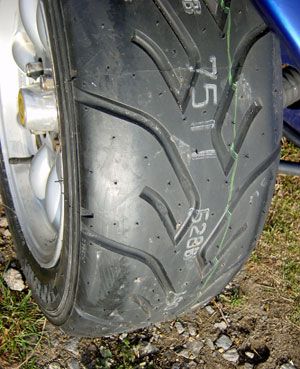 Brand new A0-48. When you get brand new tyres fitted you should be carefull for the first few miles. Release agent used in the manufacture of the tires can make them a little slippery before it has been scrubbed off, particularly in the wet. Brand new A0-48. When you get brand new tyres fitted you should be carefull for the first few miles. Release agent used in the manufacture of the tires can make them a little slippery before it has been scrubbed off, particularly in the wet.
When we purchased our first set of 48's from George Polley's he only had 195/60/14 tyres in stock - we normally fit 185's. As we were in desperate need for legal tyres, and the 195's would fit on our wheel we went for those. We had recently moved to the Staines/Ascot/Windsor area, and had noticed that the fast roads around here can be very 'jiggly' - lots of small bumps. The car did like to 'wander' and tram line more than was noticeable with narrower section tyres we had before. The car felt 'over tyred' - again, massively subjective, but we don’t need the wider tyres with our car, particularly on the front, so we changed back to 185's at the next tyre change. This made the car feel much more balanced again and we have stayed with the 185 size ever since. I shall only go back to wider rear wheels if and when we upgrade the power of our car, and require the extra traction to put the power down.
Turn in and direction change feels very secure and the front dives into the corners fantastically and with real confidence. There is a nice progressive feeling to slides - sorry 'break away' - nothing dramatic of course, just an awareness that things were happening evenly.
I have heard a few people express opinions that they do not think the 48's are much different from the 48's in the dry. This may well be true, although again I would stress that this is very subjective. The biggest difference in my opinion is in the performance in wet or damp conditions, where I think the 48's are vastly superior.
In conclusion I think the A0-48r's are a fantastic all round tyre. They perform superbly on road and track, wet or dry, and as such I am happy to use them all year round, whatever the conditions.
Rough price guide (185/60/14): £55

The point about 32r's and 48r's is that they start off with a shallower tread pattern than 21r's, so they have less to wear away before becoming illegal, but to be honest I have never thought the wear rate/fun factor to be a problem. The compound of the 48's according to GPolley is the same as the 21's, and at the moment unlike the 32's they are only available in one compound. A0-32's are available in 'Soft' (S) and 'Super Soft' (SS) compounds. We have always used 'Soft' all round - although if we use 32's again we will follow common practice and use 'Soft' on the rears and 'SuperSoft' on the fronts. This helps front end grip and should reduce understeer. Having said that, I am very happy with the 48's, so we would only return to 32's if there is an availability problem with the 48's.
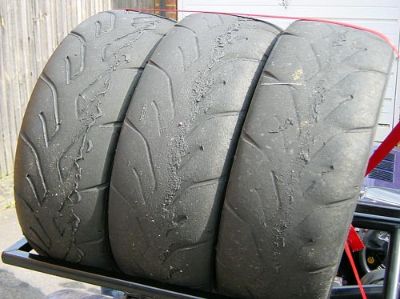 Some 'slightly past their best' 48's, shown after a great day at the Llandow Circuit - sure sign of a fun day! Some 'slightly past their best' 48's, shown after a great day at the Llandow Circuit - sure sign of a fun day!
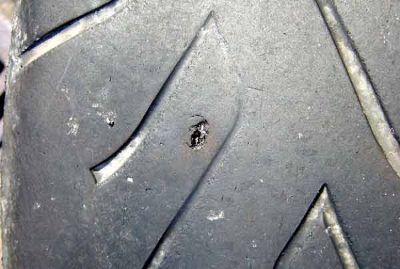 I picked up my first ever puncture in the middle of Avebury Stone Circle in Wiltshire - a screw somehow managed to pierce the admittedly rather thin rubber on the rear wheel! I picked up my first ever puncture in the middle of Avebury Stone Circle in Wiltshire - a screw somehow managed to pierce the admittedly rather thin rubber on the rear wheel!
The puncture shown above happened about 80 miles from home. No problem - we carry a spare. Except we didn't because I had taken it off for the Llandow track day. However I had put a can of tyre weld in the boot - just in case. I was very impressed with how this stuff worked. It filled the tyre quickly, and was very stable. I am ashamed to say that I ran the car on this for about two weeks before getting a new tyre!
 A tyre rack enables you to take a set of tyres to a track day and not worry about having legal tyres at the end of the day. Note the mud! I swear our car is one of the hardest working Caterhams out there! A tyre rack enables you to take a set of tyres to a track day and not worry about having legal tyres at the end of the day. Note the mud! I swear our car is one of the hardest working Caterhams out there!
We picked up a second hand set of alloys so we could fit old non road legal tyres and use them on trackdays and particularly at more abrasive airfield days.
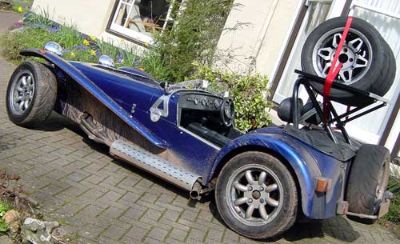 Car drives fine with all that extra weight high up at the back. Obviously you are aware of it - don't corner quite so hard, and don't expect the mpg to be so good! Car drives fine with all that extra weight high up at the back. Obviously you are aware of it - don't corner quite so hard, and don't expect the mpg to be so good!
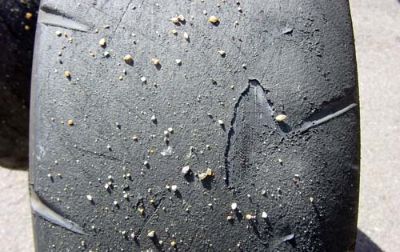 Ah! - the fun that can be had with some old useless tyres, a Limited Slip Differential and a piece of industrial wasteland!! Ah! - the fun that can be had with some old useless tyres, a Limited Slip Differential and a piece of industrial wasteland!!
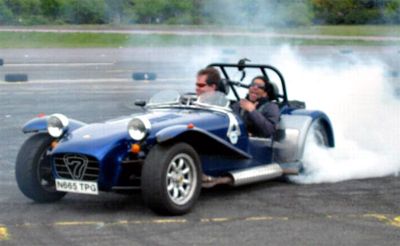 L7Club Brooklands Hooligan Day - Adil choking! L7Club Brooklands Hooligan Day - Adil choking!
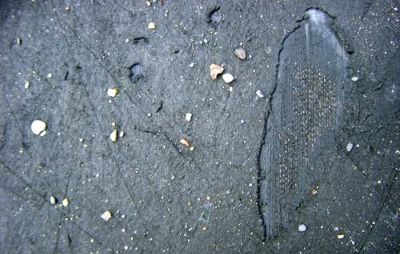 And again in glorious close-up! Note the canvas showing through the de-laminated chunk! (Incidently, don't push tyres much more than this - a de-lamination will take out a wing with ease.) And again in glorious close-up! Note the canvas showing through the de-laminated chunk! (Incidently, don't push tyres much more than this - a de-lamination will take out a wing with ease.)

I have ordered all our tyres from George Polley Motorsport. If you find anywhere better value or more helpful then let me know. They are always willing to chat about requirements and answer questions freely and honestly. If they are don’t have what you want they will suggest an alternative supplier. They send the tyres anywhere, and carriage is ridiculously cheap – about £10 for 4 tyres. Not bad when many other parts suppliers will charge the same for posting a single small component!

I can only speak from my own personal experiences, and from the way we use the car. It is notoriously difficult to describe 'feel' and handling of a car. Everyone has different reference points to begin with, everyone drives differently, and everyone has different expectations. You may read conflicting opinions on tires elsewhere. I have tried to keep my descriptions here subjective and as clear as possible, and in my opinion these provide a reasonably accurate impression of the tyres, and of the differences between each model.
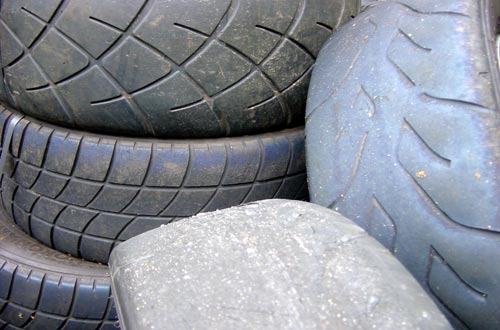 | | The Joy of Rubber |
| 

